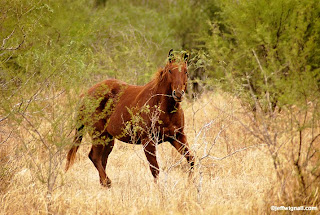 A lot of depth of field is a great thing if you want everything in your pictures to be in sharp focus. But there are times when you might want to limit or restrict depth of field so that only your main subject is sharply focused and the background and/or foreground is less sharp. The main reason for doing this is to accent your primary subject--in a head-and-shoulders portrait, for example--where you want your subject's face in sharp focus but want to toss the background into a soft blur.
A lot of depth of field is a great thing if you want everything in your pictures to be in sharp focus. But there are times when you might want to limit or restrict depth of field so that only your main subject is sharply focused and the background and/or foreground is less sharp. The main reason for doing this is to accent your primary subject--in a head-and-shoulders portrait, for example--where you want your subject's face in sharp focus but want to toss the background into a soft blur.You can reduce the amount of depth of field by simply reversing the things we talked about in the previous tip. Again, here are the primary factors:
- Lens focal length: The longer the focal length of the lens, the less depth of field you will have at any given aperture (f/stop) and at any given distance. As you zoom a lens from wide to telephoto, for example, you quickly lose depth of field (provided you are keeping the aperture the same, see below). I used a 70-300mm Nikkor AFS lens at the 300mm position (450mm in 35mm terms) to shoot this horse on the King Ranch in Kingsville, Texas partly because I needed the long lens to bring the wild horse close, but also so that I could throw the foreground scrub and background out of focus.
- Lens aperture: The wider the aperture (again, assuming focal length and subject distance are constant) the less depth of field. You will get significantly less depth of field at f/4 than at f/16, for example. Think "smaller" f/stop numbers = larger lens openings = less depth of field. Remember, this does not affect how sharp your subject will be if you focus carefully, the larger aperture only reduces the near-to-far sharpness.
- Subject distance: The closer you are to your main subject, the less that will be in sharp focus in front of and behind the subject. Want less depth of field? Move closer. Want more? Get farther away from your subject.
Keep in mind, if you're shooting with a point-and-shoot camera, you'll have less control when it comes to restricting depth of field because they tend to have inherently smaller apertures which (you knew this already!) creates more depth of field.
Finally, if you're shooting in bright light and the camera won't allow you to use a wide aperture, even at a high shutter speed, you can use a neutral-density filter in front of the lens to reduce the light. These filters won't affect color but reduce the amount of light entering the lens. I'll write a tip of "ND" filters in the future.






2 comments:
I liked these two articles. I always seem to have a problem with getting the background out of focus when the subject is close to me. Even when shooting in aperture mode on my camera the pictures never seem right with my 17-70mm lens. I'll try some of these tips.
The problem with limiting depth of field with the 17-70 Mike is that the lens is very wide-angle and has a lot of inherent depth of field. Depth of field increases as the lens gets wider, so you're getting a lot of depth of field even at wide apertures.
Post a Comment